As a professional Romanticist, I’ve spent time swimming in pools—lakes, ponds—of melancholy and loss. In this liquid milieu, I learned about tears and thoughts too deep for tears. Lately though, I find myself in a more desiccated landscape, lit with fiery rage. When I was young, feelings of sorrow and rage converged; it seemed to me all one terrain. The girl cried while fighting; she fought while crying. Now I stare at the response emoji on Facebook where a face wet with tears sits apart from one burning with anger, each a distinct emotional ecosystem. In these heydays of chaos, can’t we find ways to hold together tears and anger, water and fire?
Part of this question I borrow from Stanley Cavell, as he considers “the unknown woman” of Hollywood melodramas of the ’30s and 40s. Are we up to, he wonders, have we forms of intelligibility strong enough to match “the heydays of chaos reaching our ears?” (Cavell 45). For Cavell, the heroine of melodrama presents one such form. She figures a specific kind of unknown-ness, he writes, in which she appears “powerless to make [herself] known,” because in the current world she remains unwelcome on her own terms. Equally unheard on her own terms, this misfit inhabits extreme states of structural “voicelessness,” an incomprehension or suppression of her voice that can amount to “suffocation” (43). In the isolation which attends the voicelessness of the heroine of melodrama, Cavell discovers the source of her critical power, “her ability to judge the world” (16). In addition to the unknown woman, other features distinguish these melodramas: conversation brought to an impasse (particularly between woman and man); a past that has been “frozen, mysterious, with topics forbidden”; and “the negation of marriage itself,” especially “marriage as a route to creation” and happiness (6).
But it is most pointedly in the theatrical, excessive, desperate, and, I would add, often lyrical expression of a woman’s suffocating voicelessness that we find the possibility of alternate, alien forms of intelligibility, forms strong enough perhaps to match our own heydays of chaos.
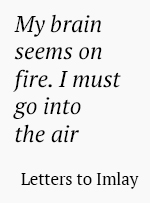
The melodrama of the unknown woman is for Cavell an avenue to philosophy itself (“the opening knowledge of the human is conceived as the experience of being unknown”), its gendered politics muted though not absolutely unvoiced (22).
Several feminist thinkers have effectively bent Cavell’s insights toward a consideration of modern feminism, itself often unwelcome and unheard on its own terms. Like Cavell they discover surprising resources embedded in melodrama. Lauren Berlant, Sara Ahmed, and others have pinpointed the melodramatic “female complaint,” “feminist killjoy,” and “affect alien” as agents of feminist and queer critique. To resist “getting along,” to refuse to “move on” or align with conventional notions of progress and happiness serves, in Ahmed’s words, to “expose the bad feelings that get hidden, displaced, or negated”—and consequently unknown—“under public signs of joy.” If one recognizes “the objects that promise happiness to be not quite so promising,” a coincident sadness and anger may leap forth (Ahmed 38–39). Melodrama relies on those angrily sad and sadly angry ones who, in Ahmed’s terms, are “prepared to kill some forms of joy”— even if it requires, in some cases, killing themselves (50).
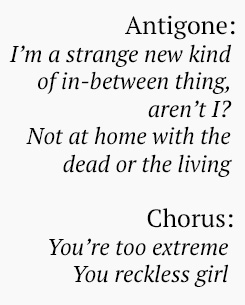
These concerns—of sorrow as anger, of voicelessness as voices unheard—and the forms for their intelligibility all meet in Mary Wollstonecraft’s last finished work, the remarkable Letters Written During a Short Residence in Sweden, Norway, and Denmark (1796). The same concerns motivate Bonnie Honig’s revisionary reading of Sophocles’ Antigone for contemporary feminist political theory. Approaching the Letters Written During a Short Residence as Honig approaches Antigone, through the lens of melodrama, makes intelligible feminist possibilities in Wollstonecraft’s most plaintive—and, I would suggest, quite angry—work, composed between her two attempts at suicide. When we place Wollstonecraft’s Letters Written alongside recent feminist work on Antigone, we begin to hear what is unvoiced or barely voiced in her writing. We discover a vital and timely feminist poetics.
In turning to Antigone, feminist scholars add a question prior to the one concerning forms of intelligibility: do we have ears disposed to catch the un- or under-known, the un- or under-voiced? When Sophocles’ heroine reflects, “I’m a strange new kind of in-between thing, aren’t I? / Not at home with the dead or the living,” the Theban Chorus refuses to hear her: “You’re too extreme / you reckless girl” (Sophocles 39). When Wollstonecraft, writing to Gilbert Imlay after her first suicide attempt, writes: "I . . . seem to have no home, no resting place to look to—I am strangely cast off," is she also too extreme? Is he even listening? (Works 6:426–27). Wollstonecraft rewrote this and other letters from her travels in Scandinavia for the published Letters Written. Even after reclaiming her letters, though, her questions persist: “Life, what art thou? Where goes this breath? this I, so much alive?” (6:279). How much does her reader hear in that cry?
I. Where Goes This Breath?
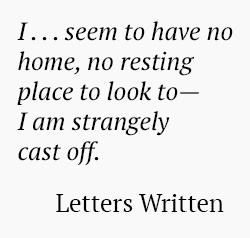
It may be a perverse thought, that a feminism derived from Sophocles’ Antigone can teach us something about Wollstonecraft. I want to pursue that thought, and also reverse it, so that we find Wollstonecraft shaping the reception of a feminist Antigone. Investigation suggests the story of Antigone had no direct influence on Wollstonecraft. In his sweeping survey, Antigones: How the Antigone Legend Has Endured in Western Literature, Art, and Thought, George Steiner dates the start of the “Antigone vogue” almost exactly to the time of Wollstonecraft’s death. He muses that she, Jeanne Manon Roland, and Germaine de Stael share a “resonance” that anticipates Antigone’s subsequent Romantic appeal (Steiner 7, 10). Whether Antigone “resonated” with Wollstonecraft, whether she read or saw the play, remains unknown. A student of the philosophical travelogue, she very probably read Barthélemy’s popular Travels of Anacharsis the Younger (1788), where, after watching Sophocles’ tragedy performed, Anacharsis stands exhausted: “I had no more tears to shed” (qtd. in Steiner 7).
Steiner finds this dehydrated “seminal passage . . . echoed” by Antigone’s male admirers throughout the nineteenth century (7). We know that Antigone captivated German philosophers and poets circa 1800, that Wollstonecraft’s son-in-law Percy Shelley later confessed his adoration for the play’s “godlike victim” (“Some of us,” he wrote, “have in a prior existence been in love with an Antigone”); and we know, thanks to Yopie Prins, that Antigone was an alluring figure for later “women of Greek Letters” (qtd. in Steiner 10; Prins 234–36). Yet in eighteenth-century literary circles, Antigone remained a minor character, seldom on stage and celebrated primarily as devoted daughter or star-crossed lover, with no signal appeal for women intellectuals. That Antigone had little appeal, found no audience, accords with a point she makes herself: “O reaches of the plains of Thebes,” she complains, “no one sheds a tear for me” (Sophocles 39). Wollstonecraft makes a similar cry, near the close of her Letters, “Why should I weep for myself?—‘Take, O world, thy much indebted tear!’” (6:344). This last, perplexing cry will return later, but for now it tells that the legacy of Wollstonecraft, like that of Antigone, is tied up with the limits not just of intelligibility, but also of tears: a melodramatic legacy.

In addition to the apparent anachronism of my pairing, there is the generic mismatch of a figure from classical tragedy with an epistolary first-person narrator. Antigone: tragic, timeless, defiant even of worldly time. Wollstonecraft’s traveler: subject to a historical moment she strains to transcend. Her persona—a single mother traveling alone after a period of emotional duress, writing to an unresponsive “you”—appears ripe for film melodrama, uncannily like the anonymous woman in Max Ophuls’ Letter from an Unknown Woman or Charlotte Vane in Now Voyager.
Despite generic discrepancies, though, Antigone and Wollstonecraft do both serve as icons for Western feminism: person and persona, melodramatic and tragic, larger than life. It’s worth recalling Lacan’s thought that the “figure of Antigone forms part of our [i.e., Western] morality” whether we know it or not; worth recalling too is Honig’s conviction that “the idea that we [in the West] could . . . think politically in ways untouched by [Antigone] is as improbable as Oedipus’s hope that he could . . . live out his life . . . untouched by fate” (Lacan 284; Honig 37). By these accounts, any feminist politics or moral philosophy must be touched by Antigone. Lacan’s thought and Honig’s conviction suggest a Wollstonecraft—and a feminism—inevitably touched by tragedy, myth, and fatalism. They suggest consequently the touch of timelessness brushing against any feminism living in time.
But what of the inverse, the conviction that Wollstonecraft’s Romantic feminism, a feminism in time, touches on myth? Or that Antigone cannot be understood without Wollstonecraft?
When Steiner remarks that the “life” of Wollstonecraft “resonates” with the figure of Antigone elevated by nineteenth-century writers, he implies that Wollstonecraft forecasts the image of Antigone forged by Schiller, Hegel, and subsequent writers: a modern Antigone “emblematic of a programme of feminine emancipation and political parity” (Steiner 9–10). If, for instance, one considers Antigone from the angle of Wollstonecraft’s Letters Written, striking correlations appear. Neither woman “knows her place”: they insist on venturing outside the walls of domestic space. Both stand—scandalously—outside the institution of marriage. Both provoke comment that they speak like men. Both women find themselves in a landscape riven by war and death. Isolated by grief, each announces her grievances against the gendered lifeworld that surrounds her, a lifeworld that hardly responds. Each obsesses about confinement, suffocation, and being shut up. Each identifies repeatedly with birds and other creatures with wings.
Despite opposition and neglect, each woman labors to hold forth. They take, we are told repeatedly, their time. And each one attempts to take her life.
With these resonances in mind, one can begin to see how, marked by the limits of gender, by suicide and mourning, the tragedy of Antigone and Wollstonecraft’s Letters Written During a Short Residence both reach for forms that confound the sorrow of this world with unending rage. In doing so, they adopt timelessness, unendingness, as a critical alternative to living in the present.
II. Killing Time, Taking Time
Sophocles’ tragedy opens at dawn, with Antigone trying to recruit her sister Ismene’s help in burying their brother Polyneikes. Their uncle Kreon, ruler of Thebes, has commanded that Polyneikes’ corpse remain unburied and dishonored, carrion for the birds that circle beyond the walls of the city. When Ismene balks, Antigone grows scornful. The scene ends with Antigone rebuking her sister: “I would not take your help now if you asked me” and with Ismene offering this blessing: “Go then but know / although you go without your mind / you go as one beloved” (Sophocles 15).
(The translations here are by Anne Carson, another feminist taken with Antigone).
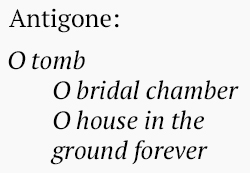
Soon afterward a sentry reports to Kreon that Polyneikes’ corpse has been mysteriously covered with dust; later, guards catch Antigone trying to re-cover it. Kreon sentences his rebellious niece to be buried alive. Ismene begs to join her; Antigone declines the offer: “Take heart and live, Ismene / my soul died long ago” (30). In an extended dirge for herself, Antigone names her prison in terms that reduce a woman’s life to one claustral spot: “O tomb / O bridal chamber / O house in the ground forever” (40). She is to be shut up, “bastilled . . . for life,” to quote Wollstonecraft’s Maria (Works 1:155).
The reckless girl subsequently thwarts Kreon by hanging herself in her tomb-prison. Dominoes begin to fall: Haemon, Antigone’s fiancé and Kreon’s son, stabs himself; his mother Eurydike follows suit. A bewildered Kreon remains alive, as does Ismene, last of the children of Oedipus and Jocasta. Beside himself with grief as the play ends, the ruler speaks of himself in the third person: “Kreon no more exists than someone who does not exist” (Sophocles 54).
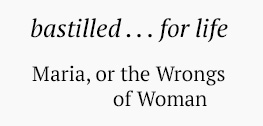
For recent feminist thinkers, Antigone plays a crucial role.
Twice Judith Butler reflects on the play, in readings that respond to the last two centuries of Western philosophical inquiry. Like her predecessors, Butler emphasizes Antigone’s defense of the burial of her brother. But Antigone’s Claim (2000) also presents the heroine as the daughter of incest who loves her dead, traitorous brother in excess of law, contesting thereby the assumed interdependency of laws of kinship and laws of state. Antigone’s words, by which the monstrously “unspeakable nevertheless makes itself heard,” are governed, Butler proposes, by catachresis, the rhetorical figure or intelligible form which “exploit[s] the very terms . . . meant to enforce its silence”: voicelessness voiced (Claim 78; also 82). In Precarious Life (2004), written in the early years of war in Iraq and Afghanistan, Butler again recommends Antigone, this time as a model for mourning that crosses the lines of enmity and amity, private and public, life and death. “Risking death herself to bury her brother against the edict of Creon,” this latter Antigone “exemplifies the political risks in defying the ban against public grief” (Precarious 46). (Like others, Butler mutes Antigone’s suicide.)
Antigone’s classical status—that is, her felt timelessness—strengthens Butler’s claims for a general sense of shared mortality, as Keri Walsh has argued. Antigone secures an eternal return to the end of human life: as it has been, so it will be, ever-endingly.
Butler’s meditations on mourning lean heavily on the expression I used to describe Kreon: “beside himself.” To be “beside oneself with rage or grief”—Butler binds the two emotions—is to be ecstatic, she explains (Precarious 24). Ecstasy supplants catachresis as the chosen form of intelligibility.
Though she associates a politics of ecstasy with “the feminist and lesbian/gay movements” of previous decades, Butler muses that perhaps such being beside oneself is “more persistent . . . maybe it is with us all along” (24). Maybe it is classic rather than historical. Here Butler finds the source of community: “Despite our differences in location and history,” she remarks, “Loss has made a tenuous ‘we’ of us all” (20).
On this account, neither “I” nor “we” have much choice about loss; being exposed happens inevitably—a circumstance that puts us within the ambit of tragedy. Butler accepts that “any narrative of personal grief would have to be a story in which the very ‘I’ who seeks to tell the story is stopped in the midst of the telling; the very ‘I’ is called into question by its relation to the Other (23; emphasis added). Such acute self-consciousness echoes Kreon, the ruler, at the end of the tragedy. Beside himself with grief, “seeking refuge from sovereignty,” he acknowledges the flimsiness of “I”: “Take Kreon away / he no more exists than someone who does not exist” (Honig 89; Sophocles 54).
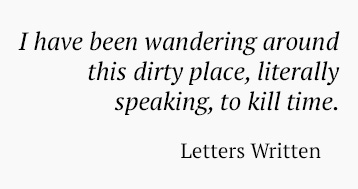
Via tragedy, Butler cultivates the timelessness of loss for the ecstatic state it discloses, a state that was there all along. It must inevitably overwhelm each living “I,” inviting it to become larger than life, more self-consciously mortal yet more ecstatically—in grief, in rage—beside itself with others, living or dead (the distinction hardly matters). But Antigone does not share this welcome fatality; Kreon does. Yes, Antigone buries her outlaw brother. Yes, she embraces the dead as she heads toward death. But the wailing lament she delivers is for herself. Voiced proleptically before she dies, staged before the chorus, her dirge protests the sentence of death and calls down vengeance. If Antigone claims timelessness, she does so by defiantly taking time for herself. She leaves not on Kreon’s terms or timetable, immured in a cave, waiting to suffocate. She refuses that fatal air. Instead she takes her own life, stealing the sovereign prerogative. Coming halfway through the play, her suicide does not fulfill tragedy. Her chosen mode of death is not inevitable.
There is losing, and there is also taking. “Take heart,” she instructs her sister, “and live” (30).
III. To Grieve
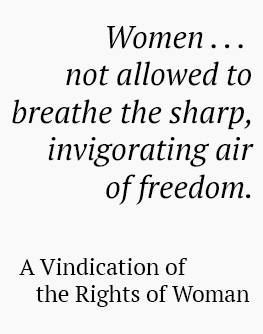
My reading of Butler’s Antigone is prompted by Antigone, Interrupted (2013), written by feminist political theorist Bonnie Honig. In part a response to Precarious Life, Honig’s book cautions against the pull of “precarity” for at least two reasons. First, because ecstatic grief risks blunting anger. In undoing sovereign power, that is, grief can undo the contestation necessary to a vital politics.
Second, Honig questions a humanism and feminism defined by fatality rather than natality. She cites Hannah Arendt’s The Human Condition to claim that being mortal “does not mean that we are born to die.” By extension, “the fact that we grieve does not mean that grief and grievability should be the center of our politics” (Honig 119–20). Honig could have recruited Luce Irigaray as well, whose most recent reflections center on Antigone’s devotion to a cosmically full life-world, where the burial of corpses is an act of ecological responsibility. For Irigaray, “The supreme value for [Antigone] is life. No other value can substitute for it: no abstract ideal, no truth or absolute” (Irigaray 9).
In the light of natality, Honig recasts Butler’s ecstatic grief into fierce, combative grievance. “To grieve,” she reminds us, “is both extra-political . . . and fundamentally political” in often uncomfortable ways. “The term connotes mourning, resistance to injustice, reification of wrong and,” she adds, “vengeance for it.” Grievance actively “takes sides” (120). Such grievance ripples the surface, for instance, when Wollstonecraft warns her reader, “I am sad . . . and have cause” (6:331).
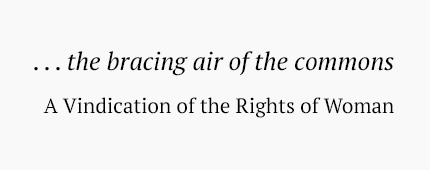
Within this layered sense of grievance in Sophocles’ drama, Honig finds active conspiracy. She asks us to hear the link between conspire and aspire (perhaps inspire and respire as well): a shared breath of possibility (91). Conspiracy can offer a “mechanism of change” within overpowering systems and structures. Partaking of both sovereignty and vulnerability, conspiracy gives us “both more and less agency than we think,” Honig argues (88). Attending to conspiracy, moreover, swings the weight of the play away from the agon of Kreon-Antigone to more intricate, lateral relationships between the sisters, Chorus, soldiers, audience, and utterances of the play (88).
Antigone’s initial effort to conspire with her sister appears to fail, but Honig suggests both women learn as they go, growing more subtle and successful as they conspire (aspire, inspire) with language and with others. A similar trajectory marks Wollstonecraft’s Letters.
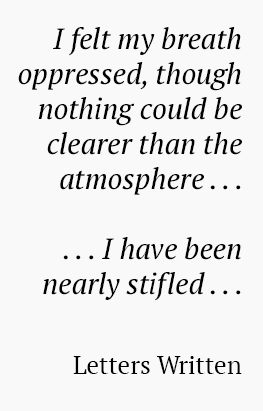
The rhetorical form favored by aspiring conspirators is adianoeta, a type of double entendre or utterance sotto voce—the blowing of dog whistles, perhaps—which, distinct from the violence of catachresis or the abandon of ecstasy, sustains plural meanings, “playing off how different audiences will understand the same locution” (Burton). Examples in the play abound, including the last exchange between Ismene and Antigone, a delicate dance performed before their uncle.
Honig highlights the extended dirge where Antigone “airs her suffering” before Kreon and a restive Chorus (Honig 122).
More than the burial of her brother, this aria bears the force of sorrow with anger; it best displays Antigone’s tie to Wollstonecraft’s Letters Written During a Short Residence. “Words that Kreon hears as mere self-indulgent lamentation,” a grieving that “goes on” too long, Honig explains, are simultaneously “seeking, soliciting, constituting publics elsewhere” (Honig 90; Sophocles 40). This is one form of grievance available to these women: openly sorrowing, covertly inciting.
Complaints deemed “too extreme” and dismissed by one audience may be cultivating other audiences: this happens when Wollstonecraft revises and then publishes her letters to Imlay, activating adianoeta each time she addresses “you,” her variously constituted readers.
In its untimely conspiracy with language, the heroine’s voice refuses a place within what Honig calls “an economy of citizenship that domesticates”—which is to say, entombs and suffocates—“desire, longing, pain and loss” (122; also 135). Think of adianoeta as one weapon in the heroine’s arsenal of excess—talking too much, borrowing without permission, reaching out beyond her immediate audience, taking what is not hers, airing grievance—in a situation defined by rigid economies of time and money, as Carson’s translation makes clear.
These weapons or tactics hurry us on to Wollstonecraft’s Letters Written.
But let’s not be rushed: let’s take our time.
IV. Always and Ever
Both Butler and Honig borrow from the work of feminist classicist Nicole Loraux, whose account of the mourning voice in classical Greek tragedy upends traditional scholarship. In distinction from the rhetorical forms that hold Honig and Butler, Loraux attends to poetics. In particular her discussion of the adverb for always—aei—discloses yet another form of intelligibility where sorrow and anger fuse. By focusing on the moments when Antigone forsakes the time of the present for the timelessness of always, we can detect the feminist implications of Loraux’s insights.
In ancient Greek, the value of always—aei—typically aligns with a vital force constantly regenerating itself. Émile Benveniste characterizes it as “transitory and permanent, running out and being reborn in the course of generations . . . subsisting forever in its endlessly beginning finitude” (qtd. in Loraux 28; emphasis added). We might think of it as the flip-side to Butler’s ever-ending mortality. Aei usually signifies an always in time and full of time (saecula saeculorum), derived from human measure, specifically the cycles of human generation. Designating a regularly renewing identity that overrides superficial alterations, the adverb aei helps secure the ongoingness of an autochthonous State. It may be familiar to us as the always of Burkean tradition (“always acting as if in the presence of canonized forefathers”) or the permanence of the classics, or even as an ever-regenerating Romanticism (Burke 102). Yet in her very name, Antigone (anti [against]—gone [birth, offspring]) protests this sort of always. For her part, Wollstonecraft in the Letters Written famously imagines an end to human ongoingness, a time “when the earth could no longer support [man]. Where was he to fly from universal famine? . . . The world appeared a vast prison” (102).

Loraux calls attention though to a mutant version of always alive in the tragedies, especially Sophocles’. There the adverb aei “does not belong to [humans]” but to the atemporality of gods immune to death. It attaches particularly to passion and obsession, to madness, or, in Antigone’s case, to what Loraux designates as a “rigid indeterminability” (or unendingness) for which her world has no terms (31). Protagonists like Antigone export their grieving outside the strictures of state law to the timeless realm of this other aei. Their “passion lives by claiming for itself aei, always, as its temporality” (32; emphasis added). Loraux’s choice of verb accentuates the implication: the interminable griever grabs at a mode of life untethered to generation, mortality, or fatality. In the tragedies aei issues “a repetitive de-negation” of “man’s destiny as mortal,” as “made of death” (34). Such grieving flies against the Greek polis and its monopoly on always.
Additionally, as a “fierce and obstinate rejection of forgetting,” this aie protests separating past from present (34).
Such timelessness belongs to the gods—and to a lyric mode that presses beyond language. It penetrates the sonic texture of tragedy, Loraux finds, each time the word repeats exhalations of grief. Aiai—an exclamation like “alas!”—reverberates in aei and in its combinations so that when, for instance, Antigone exclaims, “O home in the ground forever,” the word signifying forever (άϴίφρουρο/aeiphrouros) redoubles her plaint. The aei of always sings out in ubiquitous cries (Aiai), but also in internal rhymes, freighted moments of assonance, and frequent passages of song. Always and alas thus conspire with the singing of choral refrains. Like Honig’s adianoeta, they are there waiting to be heard.
Loraux makes analogies between these phonic signals in the tragedies and oratorio or lyric poetry (51). But emphasizing the role of sound and song in tragic grieving pulls her account close to a particularly Romantic form of intelligibility, by which that era’s heyday of chaos reached many ears. Emergent even as Antigone assumed her place in modern Western thought as “emblematic of a programme of feminine emancipation and political parity,” even as the author of A Vindication of the Rights of Woman died from giving birth, that form is melodrama (Steiner 9–10).
V. Still Harping
At this point you may be feeling sad and angry that this essay has not engaged Wollstonecraft’s writing in much detail. But perhaps, insofar as Mary Wollstonecraft helped write the script for a modern Antigone, this essay has been talking about Wollstonecraft’s work all along.
In addition to anticipating Antigone, Wollstonecraft anticipated in her Letters Written such moments of audience annoyance (“You will say that I am growing bitter, perhaps personal—Ah! Shall I whisper to you that you—yourself—are strangely altered?’?” [172]) as well as audience impatience (“Still harping on the same subject, you will exclaim——How can I avoid it . . . ?” [153]). Her ventriloquism offers moments of adianoeta that further conspiracy, splitting the nominal letter-reader apart from readers of the published text, whom she woos to her sense of grievance. Playing too on the distance of the spoken from the written word, she insists on being heard even as she anticipates the desire for her to be quiet (“shall I whisper to you?”).
The verb “harping” only heightens this dialectical unease, suggesting on the one hand that the letter-writer “repeat[s] or dwell[s] upon a subject to a wearisome or tedious length” and on the other “play[s] upon a [harp] string, to make music” (OED). A killjoy’s tedium to some ears may be stirring music to others. The OED cites a tone-deaf Polonius calling out Hamlet for “harping still on my daughter,” the ambivalence of the word—dwelling upon? playing upon?—opening up rich adianoetic possibilities. Are we to hear Hamlet in the letter-writer’s (ventriloquized) phrase? Wollstonecraft keeps such possibilities alive throughout the letters, as she works various potential “you”s with and against each other, her address veering from a tone of entre nous to subtle antagonism to stern command, as scholars have noted (e.g., Letters 176).
Less recognized perhaps is the fact that the letter-writer simultaneously taps into lyric potential here, hoping that the arguments she harps upon will unleash a sonic undercurrent, her own enduring aei. Here is the full paragraph, a dramatic flourish near the close of the Letters:
. . . ergo, is not man the tyrant of creation?
Still harping on the same subject, you will exclaim—How can I avoid it, when most of the struggles of an eventful life have been occasioned by the oppressed state of my sex; we reason deeply, when we forcibly feel. (153)
Many things could be said of the rhetoric of this passage—the switch to a “we” that excludes “you,” for instance, and the explicitly feminist stance. I want, though, to mark in its lyricism a premonition of the melodramatic and its service to feminism. Not simply the posture of female complaint—what Lauren Berlant recognizes as “the bitter vigilance of the intimately disappointed”—but the exploitation of lyric strategies, that singing harp, make the narrator’s voice heard even when her audience wants not to hear it (Berlant, Complaint 1). Melo+drama, of course, implies the mix of music with drama. Note the music of Wollstonecraft’s closing chiasmus: “we reason deeply when we forcibly feel.” Pleading, keening, and aggrieved, the writer plays upon one string: “We reason deeply when we forcibly feel” (ee , ee’, ee’, ee, // ee’, ee, ee’). Is this music—or the screech of nails on a chalkboard? Either way, the sound defies forgetting. You may wake tomorrow and hear it still.

In Cruel Optimism, Berlant turns to genres such as melodrama to trace how they mediate “pressures of the present moment on the subject’s sensorium”—Cavell’s “heydays of chaos reaching our ears” (9). For Wollstonecraft, lyric moments similarly mediate or channel scraps and bits of tragedy for the reader’s sensorium. The landscape of the Letters Written is littered with the dead, we recall: mummies, executions, soldiers training “to slaughter and be slaughtered,” phantoms, hauntings, and everywhere the stench of rotting fish. Wollstonecraft then fills the landscape with echoes of tragedy—Shakespeare’s specifically. In addition to Lear (Works 6:310, 322, 414) and Macbeth (6: 252, 343, 378), the letter-writer alludes to or quotes the suicidal Prince of Denmark, as when we read, “the world’s a vast prison,” or the lament that “war, and ‘the thousand ills that flesh is heir to,’ mow [men] down in shoals” (6:336; also 253, 372, 277).
Outside Tonsberg, the traveler enters a house, “the tomb of the Capulets” she calls it, where “the worm riots . . . on the cheek of beauty” (6:285). In each case, the well-known lines both recall and effect turbulence. Like Antigone, the radical egalitarian writer claims identification with royalty and nobility; yet the words she quotes, like those from Lear, attest to the futility of such distinctions: she sees “an effigy of majesty burned down to its sockets” (6:322). Whatever authority remains in the form of tragedy sounds fractured, vestigial, and gothic, relics presented in a minor key. The tragic pose thus risks sounding excessive, histrionic, overwrought: melodramatic. After all, this is a travelogue: she’s on a business trip. Yes, her lover left her and their child, but it’s not as if anyone’s been killed. . . .
Jeffrey Cox explains that in the Romantic era, the tragic hero can “only struggle to become a hero,” alienated as she is from the “fully meaningful world of gods and heroes” (Cox 158). If that’s the case, then Wollstonecraft, like the protagonists of melodrama, declines the struggle. She borrows. She feints. She plays, as the advertisement to her Letters Written confesses, the part of “little hero of each tale,” pluralizing her roles (Works 6:241; emphasis added). That pluralization has critical effect: for every reader who might hear self-indulgent sentiment on these pages, others might hear the music of unspoken acts of suicide, madness, and vengeance. Someone, something, has been killed, over and over again. Lyric strains and scattered echoes of tragedy sound against a death-strewn landscape, giving the Letters Written an excessive or “extimate” dimension, allowing a timeless sense of grievance to intrude upon a living present even as the traveler eats meals, arranges transport, and describes the local customs of dress (Honig 149). If she cannot be understood in her owns terms, she will collect, parrot, or take the language of an authority—tragic, mythic, aristocratic, sovereign—an authority she knows and exposes as hollow.
These are the tactics of melodrama, that “peculiarly modern form” born in France alongside regicide, revolution, and “the loss of a tragic vision,” and carried to Britain in 1801 by Thomas Holcroft, sometime friend of William Godwin (Brooks 14).
Honig acknowledges that the features she detects humming through Antigone—grievance, conspiracy, and the untimely lyric registers of the overwrought and inexpressible—all reverberate within the distinctly modern mode of melodrama. If Honig imports melodrama into tragedy—in order to construct a contestatory, natalist, and democratic feminist politics, open to new publics—Wollstonecraft scatters tragedy into melodrama. Or at least, in the hybrid form of her Letters—epistolary novel, travelogue, philosophical history, reverie, and memoir, threaded through with the phonos of tragedy and lyric—Wollstonecraft brings her reader to the verge of melodrama, searching for a form to make grievance intelligible. The “waning of genre” on display in melodrama, is not, Lauren Berlant reminds us, the waning of affect (Optimism 6). Tragedy declined, at least in Wollstonecraft’s declension, does not sacrifice affective power. Nor does it slacken its reach for a passionate always on behalf of “the oppressed state of my sex.”

For if melodrama collects the vestiges of a tragic vision, in its Romantic moment it also enacts “passion’s revenge” upon the sentimental mode so dominant in the late eighteenth century (Chandler 34). With modern feminism, as I have sought to suggest with and through Antigone and Wollstonecraft, melodrama demands the exhaustion of sympathetic tears and their replacement with something more aggrieved. In her Letters, Wollstonecraft conjures tears several times, and readers have taken them as signposts on a melancholy, sentimental journey away from the polemics of her two Vindications. With the help of Antigone, though, I hear something else raging through the letters of the wandering woman. The female “I” invokes tears in a gestural, stylized way: “I wished for night to hide the starting tears, or shed them on my pillow, and close my eyes on a world where I was destined to wander alone” (Works 6:298). So stylized are these mentions that the incipient tears dwindle in the course of the Letters Written to a single spare tear, no sooner summoned than disowned (“why starts the tear . . . ?” [6:272]; “The tear starts . . . I must fly” [6:294]). Such considerations lead back to the line encountered earlier, the closing gesture of the penultimate letter: “Why should I weep for myself?—‘Take, O world, thy much indebted ear!’” (6:344).
The apostrophe to the world is itself indebted to Edward Young’s influential poem, The Complaint, or Night Thoughts on Life, Death and Immortality, where it signals a selfless, religiously inspired sympathy (I ought to cry for you, world, not for myself) even as it intensifies the speaker’s isolation from any fellow feeling out there in the world. In Wollstonecraft’s hands, the isolation is compromised by quotation: obviously, she and Young share this feeling (as does Wollstonecraft’s heroine in Mary, A Fiction, who repeats the phrase). There’s an acknowledgment too, perhaps, of what her prose owes to her reading of lyric poetry. More significant, though, is the fact that the indebted line culminates several pages of mounting critique of “the whirlpool of gain,” the love of profit, and the “baleful effects of speculation,” announced at the demoralized end of a journey dictated, she implies, by “the commercial spirit” and paid for by her correspondent, himself “strangely altered” from his immersion in war speculation (6:340). In this context the language of sentiment, of tears exchanged, shows itself tainted by the credit-debt system that has enveloped wartime Europe. More even than the loss of tragic vision, melodrama exposes the bankruptcy of the sentimental. How much debt does that circulating tear carry, travelling from one cheek to another like a promissory note? Honig finds Antigone refusing her place within “an economy of citizenship that domesticates desire, longing, pain and loss” (122; also 135); Wollstonecraft carries that refusal from the domesticating economy of polis to the sentimentalizing economy of capital.
“Take, O world, thy much indebted tear” may express selfless concession, or instead it may throw tears back in the world’s face: “Take that!” Or maybe, “Take it back!”—passion’s revenge, forcibly felt.
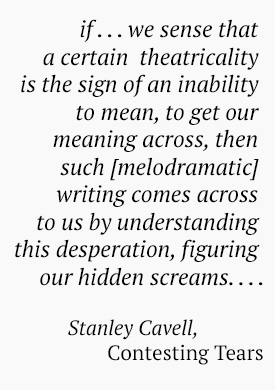
The letter-writer calls up a sentimental tear—as she calls up tragedy—to dramatize the expiration of its power. Like Antigone, she makes heard both sorrow and rage in language that echoes and implicates and speaks out of bounds, in excess of herself. In each case, with rhetorical sophistication, conspiratorial play, the sonic resources of lyric, and a desperate desire to take what hasn’t been given her, the woman voices her grievance against the state of the oppressed. She leans toward the melodramatic, suggesting the power of that mode for an unending feminism.
Aiai. Aei.
Take a breath.
Take time.
“Take heart,” Antigone says to her sister, “and live” (Carson 30).

